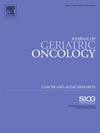评估副作用、负担和耐受性:一项探讨癌症治疗功能评估内容效度的定性研究-项目GP5
IF 3
3区 医学
Q3 GERIATRICS & GERONTOLOGY
引用次数: 0
摘要
患者报告的总体副作用负担指标,如癌症治疗功能评估项目GP5 (GP5),可用于评估癌症治疗的耐受性。单项GP5,写着“我对治疗的副作用感到困扰”,已经作为临床试验的终点。本定性研究的目的是探讨甲状腺髓样癌(MTC)患者如何概念化副作用麻烦、负担和耐受性,并产生证据支持GP5作为患者报告的MTC治疗耐受性的合适测量指标,并确定哪些反应选项构成“高副作用负担”。材料和方法通过临床试验点招募40名参加LIBRETTO-531试验(NCT04211337)的MTC患者。半结构化访谈以参与者的首选语言进行,以检查耐受性的概念,展示对GP5内容的理解,并确定哪些反应选项构成“高副作用负担”。访谈记录的主题分析与归纳和演绎编码方法的混合。结果在概念启发访谈中,患者报告副作用是一个高度相关的概念,是最接近耐受性的概念之一。有症状的、令人烦恼或负担的副作用的经历是患者如何看待治疗耐受性的关键因素。认知访谈显示GP5项目对所有参与者都清晰易懂。参与者报告了每个回答选项之间明确而具体的有意义的差异。重要的是,定性数据提供的证据表明,“高副作用负担”与大多数(60%,n = 24)访谈参与者的回答选项“相当多”和“非常多”(分别为3分和4分)一致。与会者描述了副作用麻烦、副作用负担和耐受性的概念是高度相关和相关的。GP5以一种可理解和相关的方式评估对接受MTC治疗的个人重要的概念。“高副作用负担”的定义由3分或4分适当地反映出来。这一定性证据支持GP5作为MTC比较耐受性的合适测量方法。本文章由计算机程序翻译,如有差异,请以英文原文为准。
Assessing side-effect bother, burden, and tolerability: A qualitative study exploring the content validity of the Functional Assessment of Cancer Therapy – Item GP5
Introduction
Patient-reported measures of overall side effect burden such as the Functional Assessment of Cancer Therapy - item GP5 (GP5) can be used to assess the tolerability of cancer treatments. The single-item GP5, which reads “I am bothered by side effects of treatment,” has served as an endpoint in clinical trials. The objectives of this qualitative study were to explore how participants with medullary thyroid cancer (MTC) conceptualize side effect bother, burden, and tolerability and to generate evidence to support the GP5 as a fit-for-purpose measure of patient-reported tolerability in the treatment of MTC and to establish which response options constitute “high side effect burden.”
Materials and Methods
A purposive sample of 40 participants with MTC enrolled in the LIBRETTO-531 trial (NCT04211337) were recruited via clinical trial sites. Semi-structured interviews were conducted in the participant's preferred language to examine the concept of tolerability, demonstrate understanding of the GP5 content, and establish which response options constitute “high side effect burden.” Interview transcripts were thematically analyzed with a mix of inductive and deductive coding methods.
Results
In concept elicitation interviews, patients reported side effect bother as a highly relevant concept that was among the most proximal concepts to tolerability. The experience of side effects that are symptomatic and bothersome or burdensome are key contributors to how patients perceive the tolerability of a treatment. Cognitive interviewing showed the GP5 item was clear and understandable to all participants. Participants reported clear and concrete meaningful differences between each response option. Importantly, the qualitative data provide evidence that “high side effect burden” aligns with the response options of “Quite a bit” and “Very much” (score of 3 and 4, respectively) for most (60 %, n = 24) interview participants.
Discussion
Participants described the concepts of side effect bother, side effect burden, and tolerability as highly relevant and related. The GP5 assesses a concept important to individuals undergoing treatment for MTC in a way that is understandable and relevant. The definition of “high side effect burden” is appropriately reflected by scores of 3 or 4. This qualitative evidence is supportive of the GP5 as a fit-for-purpose measure of comparative tolerability in MTC.
求助全文
通过发布文献求助,成功后即可免费获取论文全文。
去求助
来源期刊

Journal of geriatric oncology
ONCOLOGY-GERIATRICS & GERONTOLOGY
CiteScore
5.30
自引率
10.00%
发文量
379
审稿时长
80 days
期刊介绍:
The Journal of Geriatric Oncology is an international, multidisciplinary journal which is focused on advancing research in the treatment and survivorship issues of older adults with cancer, as well as literature relevant to education and policy development in geriatric oncology.
The journal welcomes the submission of manuscripts in the following categories:
• Original research articles
• Review articles
• Clinical trials
• Education and training articles
• Short communications
• Perspectives
• Meeting reports
• Letters to the Editor.
 求助内容:
求助内容: 应助结果提醒方式:
应助结果提醒方式:


